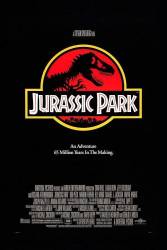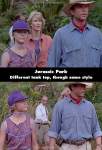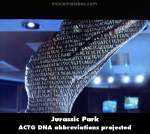Deliberate mistake: In the scene where the T-Rex is chasing the Explorer, there is a shot of the driver's side side view mirror which says, "Objects in mirror are closer than they appear." This warning is only used on convex mirrors, which are only placed on the passenger side of cars. (01:17:40)
Deliberate mistake: At the end of the kitchen scene with the kids and the raptors, one of the raptors chases Tim as he runs to the door. As it's doing this, Tim is running away with a bad limp, then as the raptor gains speed and is close behind, Tim's legs are perfectly fine as he sprints out the door and shuts it. (01:47:05)
Deliberate mistake: When the raptor breaks into the control room and is hopping around the computer workstations, we see sharp, distinct genetic coding projected from a computer screen and across the raptor's face (starting 1:55:50). Aside from the fact that computer displays have never projected focused images onto nearby surfaces, the projected text shown in this scene oddly reads from left-to-right, when it should actually be a flipped mirror-image (right-to-left). Spielberg probably realised this factual incongruity while filming but chose to use the left-to-right text for the sake of audience recognition, given that the multiple lines of "GATC" genetic code were already confusing enough. (01:55:50)
Deliberate mistake: When flying towards the island, the sea in the background is way too close. A helicopter flying over open sea would never fly that low. And when the camera cuts to an external view, the helicopter is also much, much higher.








Chosen answer: Yes. The first opening day of Disneyland in California was catastrophic. The pavement was fresh and the sun was so hot high-heeled shoes actually sunk into the walkways. Counterfeit tickets were made, resulting in more people than the park had room for. They ran out of food and drinks. Bathrooms clogged and shut down. Many of the rides broke down on opening day. The Storybook Land Canal Boats had to be pulled by cast members in rubber boots. At the time, there were no guide rails for Autopia; some of the cars crashed into each other, making them inoperable. A gas leak in Fantasyland lead to the land being temporarily closed for part of the day.
David Yard